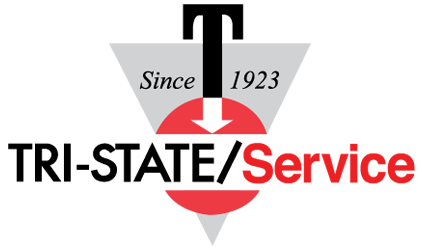From a small plant in Wheeling, West Virginia in 1923, to eleven full-service locations working in twenty states east of the Mississippi today, the Tri-State/Service Roofing & Sheet Metal Group has a proud history of service and growth.
Since 1923.
Tri-State/Service Group’s story began just after World War I. Following a summer job on a road tarring crew, Harry Esbenshade and his brother Clarence went on the road selling roofing materials for the Barret Company. The need for a specialist in built-up roofing was apparent, and in 1923 they set up their own shop in Wheeling.

Tri-State/Service Roofing & Sheet Metal Group began as a small company specializing in built-up roofing.
Pennsylvania, West Virginia, and Ohio adjoin at Wheeling, so the name Tri-State Roofing Company was adopted. As the years progressed, and the company expanded to locations outside these states, it retained the Tri-State name as a symbol of its reputation and experience.
In 1925, Harry purchased a small shop in Uniontown, Pennsylvania. In its first decade, headquartered in Uniontown after 1927, Tri-State became known and respected in the roofing business. When the Great Depression fell, capital expenditure for construction was almost non-existent. Many contractors did not survive. Tri-State prevailed largely by work on an industrial expansion project at the Celanese Plant in Cumberland, Maryland. Tri-State opened a plant there in 1938.
In 1940, Tri-State was awarded a major contract for new and re-roofing work at the Naval Ordnance Plant in Charleston, West Virginia. Closed since 1922, it soon became a vital center of wartime production, employing 7,400 workers producing ground-to-air rockets, torpedo flasks, and battleship gun barrels. A Tri-State office was opened in Charleston to handle this multi-year project. This plant led the company’s development in the sheet metal field.

Naval Ordnance Plant in Charleston, West Virginia
In 1949, the company purchased Smith and Burrows Roofing and Sheet Metal Company in Parkersburg, West Virginia. Tri-State’s Charleston office had been doing work in the area, just finishing up roofing at new DuPont and BF Goodrich plants under construction there. Sheet metal work comprised 80% of Smith and Burrows’ sales. The new location served industries in the growing Ohio Valley and posted strong sales, with work at Union Carbide, Bakelite, Electromet, PPG, Marbon, Goodyear, and Kaiser plants in the area. In addition to roofing, Tri-State served plants with architectural and other metal projects: lockers, dust collection, decking, piping, and insulated siding. The sheet metal shop began to custom design and fabricate ductwork for a variety of industrial applications. This strong connection to industry guided company service offerings and growth.
During the 1950’s, Tri-State closed its Uniontown operation, but began to serve customers in the Lexington, Kentucky area, eventually opening a branch there in 1964. By the mid-1950’s, Tri-State added metal building erection to its services. Building appearances became increasingly diverse in the 1960’s prompting more investment in metal sheeting and siding.

As it celebrated its 50th anniversary, the company changed its name from Tri-State Roofing Company to Tri-State Roofing & Sheet Metal Company, reinforcing its growing sheet metal fabrication and erection services. By this time, the company had grown to five locations, each outfitted and staffed with sheet metal artisans and an in-house metal shop capable of supporting roofing operations and other metal applications. Parkersburg and Charleston, West Virginia; Cumberland, Maryland; Lexington and Paducah, Kentucky.
By 1974, the company had an established HVAC/Mechanical division, with a full-time service organization providing installation, emergency call service, repair, and maintenance following in 1978.

Forest Roofing in Greenville, North Carolina was acquired in 1974. This office became the first Service Roofing & Sheet Metal Company. Helms Roofing in Martinsville, Virginia was purchased in 1979, becoming the group’s second Service Roofing location, followed by a third in Wilmington, North Carolina with the 1984 aquisition of Pioneer Roofing.
That same year, Marion Heating & Roofing Company in Ocala, Florida was added, becoming the southern-most office and first Marion/Service Roofing & Sheet Metal Company location.
Whitley Roofing & Sheet Metal in Richmond, Virginia was acquired, becoming Whitley/Service Roofing & Sheet Metal Company in 1990. In 2002, the company purchased a Richmond area elastomeric roof coating business, Protective Roof Maintenance.
Satellite offices were later established for Tri-State in Morgantown, West Virginia (1995); Service in Raleigh, North Carolina (2001); Marion/Service in Jacksonville, Florida (2008); and Whitley/Service in Charlottesville, Virginia (2012).
The Tri-State/Service Roofing & Sheet Metal Group continues to grow and expand to serve commercial, industrial, and institutional customers throughout the Southeast and the mid-Atlantic region.











1920’s
At the time, all that was required to get started in the roofing business was a wood-fired kettle, wheelbarrows, a truck, and a rope and wheel.
1930’s
The company adopted new materials and equipment: tube-fired kettles and roof insulation. Emergence of steel roof decking led to rapid expansion. Business boomed in West Virginia, Pennsylvania, and Maryland.
1940’s
Business continued to grow. West Virginia operations expanded into Parkersburg as the Mid-Ohio Valley entered a period of increased industrial growth.
1950’s
The company began adding sheet metal capabilities to its operations. Today, complete metal fabrication services are available at all locations.
1960’s
The 1960’s witnessed an accelerating growth pattern that continued over the following decades. Operations expanded into Kentucky and Ohio.
1970’s
The company diversified into the HVAC and mechanical contracting businesses. It moved into North Carolina and expanded in Kentucky.
1980’s
Virginia and Florida were added to the company’s markets, and operations grew in North Carolina. Roofing manufacturers increase their offerings. Company focuses on time-tested, field-proven systems.
1990’s
As the company maintained its growth momentum, it continued to expand in North Carolina, Virginia, West Virginia, and Kentucky--adding important industrial and energy industry clients.
2000’s
Company enters new century with a focus on energy efficiency and a building envelope approach to roofing systems. LEED certification and comprehensive work site safety programs lead educational efforts.
2010’s
Expansion occurs with two new offices, one in Virginia and one in Florida. Company is positioned to continue to grow to serve new markets and industries.

